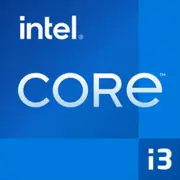Intel Core i3-10105F

Intel Core i3-10105F: Budget Processor for 2025 – Is It Worth It?
Current Review for Entry-Level Builds
1. Key Features: Modest but Effective
The Intel Core i3-10105F, released in 2021, has maintained its position in the budget segment by 2025, thanks to a balance of price and performance.
- Architecture and Process Technology:
Based on the Comet Lake microarchitecture (14 nm), which, despite its age, provides stable performance. Four cores and eight threads (Hyper-Threading) handle multitasking effectively.
- Performance:
In Geekbench 6 (2025), the processor scores 1461 points in single-core tests and 4503 points in multi-core tests. This is sufficient for everyday tasks and light gaming. For instance, in CS2 at medium settings with a GTX 1660 Super graphics card, it achieves 90–120 FPS.
- Key Features:
- Supports PCIe 3.0 (16 lanes).
- No integrated graphics (the "F" in the name).
- TDP of 65 W — low power consumption.
- Unlocked multiplier? No, overclocking is not possible.
2. Compatible Motherboards: LGA1200 Socket and Chipset Choices
The processor uses the LGA1200 socket, limiting the selection of motherboards to older but affordable models:
- Chipsets:
- H410/B460: Budget motherboards (starting at $50). Suitable for office PCs. Example: ASRock H410M-HDV.
- H470: Enhanced capabilities (faster USB ports, RAID support).
- Z490: For enthusiasts (memory overclocking, PCIe 3.0 x4 for NVMe), but it’s excessive for the i3-10105F.
- Selection Tips:
- Ensure support for DDR4-2666 MHz.
- If planning to upgrade to a Core i5/i7 10th generation — choose a motherboard with reliable VRM (e.g., MSI B460M-A Pro).
3. Memory: Only DDR4, but No Compromises
The processor works only with DDR4 (maximum frequency — 2666 MHz for H410/B460 chipsets). For comfortable operation:
- Minimum: 8 GB (2x4 GB) — for office and browsing tasks.
- Optimum: 16 GB (2x8 GB) — for gaming and video editing.
- Tip: Choose modules with low timings (CL16), such as Kingston Fury Beast DDR4-2666.
DDR5 is not supported — this is a drawback for future upgrades, but in 2025, DDR4 is still relevant for budget builds.
4. Power Supply: 400W is Ample
With a TDP of 65 W, even with a mid-range discrete graphics card (like GTX 1660 Super, TDP of 125 W), a 400–450 W power supply is sufficient. Recommendations:
- Basic option: EVGA 450 BR (80+ Bronze, $45).
- For headroom: be quiet! System Power 10 550W (in case of a graphics card upgrade).
Important: Don't skimp on the PSU! Cheap models (like Apevia) may operate unstably under load.
5. Pros and Cons: Who Is It Suitable For and Who Is It Not?
Pros:
- Price: $80–90 (new, 2025) — one of the most affordable processors with 8 threads.
- Energy efficiency: suitable for compact cases.
- Adequate performance for casual gaming (Dota 2, GTA V).
Cons:
- No PCIe 4.0/5.0 — slow NVMe SSDs (the difference is noticeable in 2025).
- Only 4 cores — demanding workloads (rendering, streaming) are challenging.
- 14 nm architecture — lags behind new Ryzen 3 in energy efficiency.
6. Use Cases: From Office to Esports
- Office and Study: Working with documents, Zoom, browsing with 20+ tabs — the processor handles without lag.
- Gaming: Paired with a graphics card like RX 6600 (1080p, medium settings) — Fortnite (100 FPS), Cyberpunk 2077 (45–55 FPS with FSR).
- Multimedia: Streaming video (4K), light editing in DaVinci Resolve (projects up to 30 minutes).
Limitations: Don't expect high performance in Blender or AutoCAD — for that, you need at least 6 cores.
7. Comparison with Competitors: Who’s Better in 2025?
- AMD Ryzen 3 3300X (4 cores/8 threads, 7 nm):
Higher performance in multi-threaded tasks (Geekbench 6 Multi ~4800), but hard to find new (used price — $70–80).
- Intel Core i5-10400F (6 cores/12 threads):
20–30% more powerful in gaming and work tasks, but costs $120–130. For those who need a buffer for the future.
- AMD Ryzen 5 5600G (6 cores/12 threads + iGPU):
Price $140, integrated graphics, PCIe 4.0 support. Best choice if the budget allows.
Conclusion: The i3-10105F only wins in price.
8. Practical Assembly Tips
- SSD is a Must: Even a budget Kingston NV2 500 GB (PCIe 3.0) will speed up the system.
- Don’t Overpay for the Motherboard: H410/B460 with 2 RAM slots is optimal.
- Cooling: The boxed cooler will suffice, but for silence, consider the DeepCool GAMMAXX 400 ($20).
- Example Build for $400:
- CPU: i3-10105F ($85)
- GPU: Intel Arc A380 ($120)
- RAM: 16 GB DDR4-2666 ($35)
- SSD: 500 GB NVMe ($40)
- PSU: 450W 80+ Bronze ($45)
- Case: DeepCool MATREXX 30 ($35).
9. Final Conclusion: Who Is the i3-10105F Suitable for in 2025?
This processor is a choice for:
- Budget Gamers, playing at 1080p on low/medium settings.
- Office PCs, where reliability and minimal cost are important.
- Home Media Centers (4K viewing, streaming).
Why It? For $80–90, you get a proven platform with enough performance for basic tasks. However, if your budget allows $120–150, it’s better to go for the Ryzen 5 5500 or the i5-10400F — they will last longer.
Future Alternative: If possible, save on the processor now, so you can upgrade to the i5-11400F in a year (which will require changing the motherboard).
If you are building a PC "here and now" and want to minimize expenses — the i3-10105F is still relevant. But remember: technology does not stand still, and even budget newcomers in 2025 may offer more for the same money.
Basic
CPU Specifications
Memory Specifications
Miscellaneous
Benchmarks
Compared to Other CPU
Share in social media
Or Link To Us
<a href="https://cputronic.com/cpu/intel-core-i3-10105f" target="_blank">Intel Core i3-10105F</a>